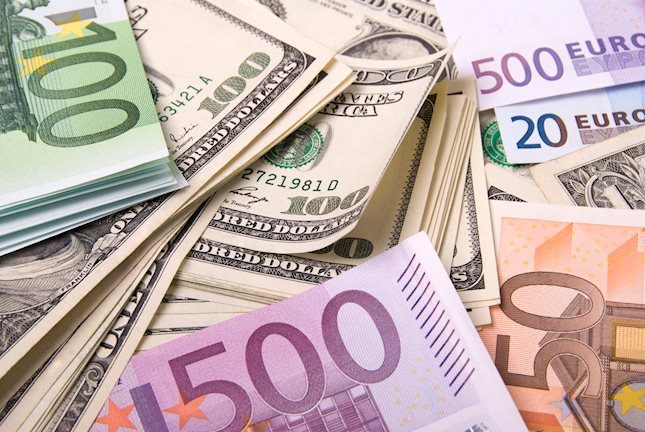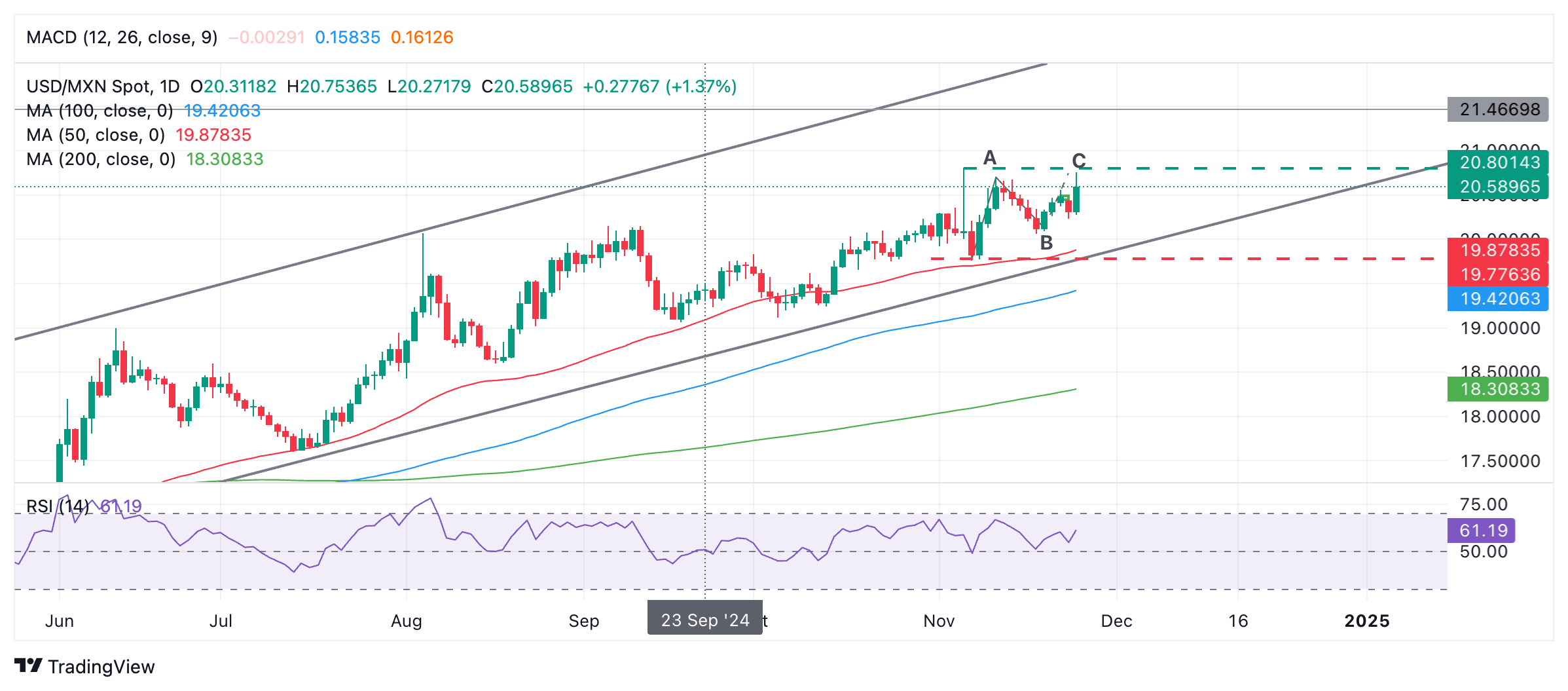- The Mexican Peso slides into a ravine after Donald Trump threatens to slap 25% tariffs on Mexican imports.
- The Peso faces further pressure from expectations that Banxico will start cutting interest rates more aggressively due to easing inflation.
- Technically, USD/MXN rallies to the top of a mini range within which it oscillates in the short term.
The Mexican Peso (MXN) declines by an average of over one percent in its most-traded pairs on Tuesday after President-elect Donald Trump said he would place a 25% tariff on goods entering the US from Mexico and Canada unless the countries reduced illegal migration and the cross-border traffic in illicit drugs. Trump's threat was mainly aimed at Mexico, where powerful cartels manufacture Fyentanol before smuggling it across the border into the US.
The MXN weakened to 20.75 Pesos to one US Dollar (USD) on the news, from a closing price of 20.31 on Monday. Mexico is one of the US’s largest trading partners, with imports from the country totalling $454.8 billion in 2022, up 18.9% ($72.2 billion) from 2021, according to the Office of the United States Trade Representative.
The imposition of tariffs of 25% would be expected to hurt demand for Mexican-made goods and for the Mexican Peso to purchase them.
Mexican Peso faces pressure from Banxico easing
The Mexican Peso is facing further pressure from market expectations that the Bank of Mexico (Banxico) could start to cut interest rates more aggressively in future meetings following a deceleration of inflation in November’s data. Lower interest rates are usually negative for a currency as they reduce foreign capital inflows.
Mexican financial daily El Financiero noted that the headline inflation rate fell to 4.56% year-over-year in the first two weeks of November. This was below the average of 4.65% based on a Bloomberg survey of analysts.
On Monday, the Peso made a brief but strong recovery against the USD on the news that Trump had picked hedge-fund manager Scott Bessent as his favorite for the post of US Treasury Secretary when he takes over in January.
The Dollar weakened on the news as Bessent is viewed as fiscally conservative and, therefore, likely to restrain spending, tempering the inflationary effects of Trump’s economic policy agenda. The Peso saw gains as Bessent was expected to predominantly target China with tariffs rather than Mexico or Canada.
Tuesday’s losses, however, more than erased the gains made on the first day of the week.
Technical Analysis: USD/MXN rises to top of mini range
USD/MXN rallies and fills the market gap opened on Monday.
The pair has now reached close to the top of the mini range (green dashed line on chart below) formed during November. This is also the C wave of a Measured Move pattern that has unfolded within the confines of the range. These patterns are like zig-zags in which waves A and C are of similar length.
USD/MXN Daily Chart
USD/MXN is probably range-bound in the short term as it oscillates between the 19.70s and 20.80s. In the medium and long term, however, it is still in an uptrend within a rising channel.
It would require a decisive break above the top of the range at 20.80 to signal the start of a more bullish short-term trend in line with longer-term up cycles.
In the absence of such a breakout, the pair is likely to continue to oscillate within the parameters of its range, with the next move probably back down towards the range floor in the 19.70s.
A decisive breakout higher would be one accompanied by a long green candle that pierced and rose well above the range highs, closing near its highs, or three green candles in a row that broke above the level.
Mexican Peso FAQs
The Mexican Peso (MXN) is the most traded currency among its Latin American peers. Its value is broadly determined by the performance of the Mexican economy, the country’s central bank’s policy, the amount of foreign investment in the country and even the levels of remittances sent by Mexicans who live abroad, particularly in the United States. Geopolitical trends can also move MXN: for example, the process of nearshoring – or the decision by some firms to relocate manufacturing capacity and supply chains closer to their home countries – is also seen as a catalyst for the Mexican currency as the country is considered a key manufacturing hub in the American continent. Another catalyst for MXN is Oil prices as Mexico is a key exporter of the commodity.
The main objective of Mexico’s central bank, also known as Banxico, is to maintain inflation at low and stable levels (at or close to its target of 3%, the midpoint in a tolerance band of between 2% and 4%). To this end, the bank sets an appropriate level of interest rates. When inflation is too high, Banxico will attempt to tame it by raising interest rates, making it more expensive for households and businesses to borrow money, thus cooling demand and the overall economy. Higher interest rates are generally positive for the Mexican Peso (MXN) as they lead to higher yields, making the country a more attractive place for investors. On the contrary, lower interest rates tend to weaken MXN.
Macroeconomic data releases are key to assess the state of the economy and can have an impact on the Mexican Peso (MXN) valuation. A strong Mexican economy, based on high economic growth, low unemployment and high confidence is good for MXN. Not only does it attract more foreign investment but it may encourage the Bank of Mexico (Banxico) to increase interest rates, particularly if this strength comes together with elevated inflation. However, if economic data is weak, MXN is likely to depreciate.
As an emerging-market currency, the Mexican Peso (MXN) tends to strive during risk-on periods, or when investors perceive that broader market risks are low and thus are eager to engage with investments that carry a higher risk. Conversely, MXN tends to weaken at times of market turbulence or economic uncertainty as investors tend to sell higher-risk assets and flee to the more-stable safe havens.
Information on these pages contains forward-looking statements that involve risks and uncertainties. Markets and instruments profiled on this page are for informational purposes only and should not in any way come across as a recommendation to buy or sell in these assets. You should do your own thorough research before making any investment decisions. FXStreet does not in any way guarantee that this information is free from mistakes, errors, or material misstatements. It also does not guarantee that this information is of a timely nature. Investing in Open Markets involves a great deal of risk, including the loss of all or a portion of your investment, as well as emotional distress. All risks, losses and costs associated with investing, including total loss of principal, are your responsibility. The views and opinions expressed in this article are those of the authors and do not necessarily reflect the official policy or position of FXStreet nor its advertisers. The author will not be held responsible for information that is found at the end of links posted on this page.
If not otherwise explicitly mentioned in the body of the article, at the time of writing, the author has no position in any stock mentioned in this article and no business relationship with any company mentioned. The author has not received compensation for writing this article, other than from FXStreet.
FXStreet and the author do not provide personalized recommendations. The author makes no representations as to the accuracy, completeness, or suitability of this information. FXStreet and the author will not be liable for any errors, omissions or any losses, injuries or damages arising from this information and its display or use. Errors and omissions excepted.
The author and FXStreet are not registered investment advisors and nothing in this article is intended to be investment advice.
Recommended content
Editors’ Picks

EUR/USD clings to daily gains near 1.0300 after US PMI data
EUR/USD trades in positive territory at around 1.0300 on Friday. The pair breathes a sigh of relief as the US Dollar rally stalls, even as markets stay cautious amid geopolitical risks and Trump's tariff plans. US ISM PMI improved to 49.3 in December, beating expectations.

GBP/USD holds around 1.2400 as the mood improves
GBP/USD preserves its recovery momentum and trades around 1.2400 in the American session on Friday. A broad pullback in the US Dollar allows the pair to find some respite after losing over 1% on Thursday. A better mood limits US Dollar gains.

Gold retreats below $2,650 in quiet end to the week
Gold shed some ground on Friday after rising more than 1% on Thursday. The benchmark 10-year US Treasury bond yield trimmed pre-opening losses and stands at around 4.57%, undermining demand for the bright metal. Market players await next week's first-tier data.

Stellar bulls aim for double-digit rally ahead
Stellar extends its gains, trading above $0.45 on Friday after rallying more than 32% this week. On-chain data indicates further rally as XLM’s Open Interest and Total Value Locked rise. Additionally, the technical outlook suggests a rally continuation projection of further 40% gains.

Week ahead – US NFP to test the markets, Eurozone CPI data also in focus
King Dollar flexes its muscles ahead of Friday’s NFP. Eurozone flash CPI numbers awaited as euro bleeds. Canada’s jobs data to impact bets of a January BoC cut. Australia’s CPI and Japan’s wages also on tap.

Best Forex Brokers with Low Spreads
VERIFIED Low spreads are crucial for reducing trading costs. Explore top Forex brokers offering competitive spreads and high leverage. Compare options for EUR/USD, GBP/USD, USD/JPY, and Gold.
